ISSN ONLINE(2319-8753)PRINT(2347-6710)
ISSN ONLINE(2319-8753)PRINT(2347-6710)
S.Revathi1, Dr.R.Kumutha2 and Dr.K.Vijai3
|
| Related article at Pubmed, Scholar Google |
Visit for more related articles at International Journal of Innovative Research in Science, Engineering and Technology
This paper highlights the feasibility study on the utilization of groundnut husk ash as an alternative material for conventional fine aggregate (river sand). For the experimental investigation, mortar mixes were prepared by replacing conventional fine aggregate with groundnut husk ash in percentages of 0, 10, 20, 30, 40, 50 and 60.Tests were carried out to find out the compressive strength, density, water absorption and sorptivity of mortar specimens prepared by partial replacement of natural river sand using groundnut husk ash and a comparison was also made with conventional mortar specimens
Keywords |
| Groundnut husk ash, Fine aggregate, Compressive strength, Density, Water Absorption ,Sorptivity. |
INTRODUCTION |
| Fine aggregates (sand) make up the main bulk of masonry mortar and therefore have a significant effect upon the properties of the product in both fresh and hardened state. The selection of suitable aggregates, which are capable of producing a product with the optimum properties, is very important. Mortar is responsible for creating a uniform stress distribution correcting the irregularities of blocks and accommodating deformations associated to thermal expansion and shrinkage. Mortar is the material responsible for the distribution of stresses in masonry structures. The knowledge about the fresh and hardened properties of mortar is fundamental to ensure a good performance of masonry walls. If the large amount of agricultural waste materials generated were used in the construction industry instead of natural materials there would be three benefits: conservation of natural resources, disposal of waste materials and freeing up of valuable land for other uses. In this paper an attempt has been made to see the possibility of using groundnut husk ash as fine aggregates in the making of cement mortar. |
MATERIALS AND METHODS |
Materials used |
Fine aggregates |
| The fine aggregate used for the study consist of natural river sand and groundnut husk ash. The fine aggregate was sieved by using 4.75 mm sieve to eliminate deleterious materials and over sized particles. Groundnut husk ash was used as a replacement material for natural river sand. The fine aggregates used in the present investigation confirms to the requirements of Indian standard specifications as shown in Table 1. |
 |
Cement |
| The cement used for this study is Portland Pozzolana cement. The specific gravity of cement was tested as per IS: 4031 (Part III) - 1988 and was found to be 3.1. |
Mix Proportions |
| A Mix ratio of 1:2 (Cement: Fine aggregate) was adopted to prepare the test samples. The mix proportions were arrived by using Cement, Fine aggregate and Groundnut husk ash. Water - cement ratio was kept as 0.6 for all the mixes. Seven mix combinations were tried by changing proportions of Groundnut husk ash and natural river sand. The details of the different mix proportions are shown in Table 2. |
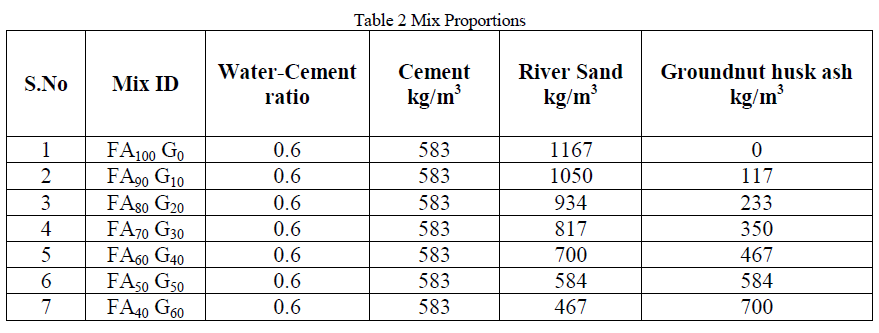 |
Preparation of test specimens |
| Density , compressive strength, water absorption and sorptivity was found out using mortar cubes of standard size 70.7 mm x 70.7 mm x 70.7 mm. Totally 63 mortar cubes were cast with 9 cubes for each mix ratio. Out of 63 mortar cubes 21 cubes were used to find the average density and compressive strength. Before subjecting the specimens to compression test, each specimen was weighed to find out the density. Another 21 specimens were used to determine the water absorption. For sorptivity test, another 21 mortar cubes were used. |
Test Procedure |
| Density of mortar cubes is calculated by dividing the mass by the volume of mortar cube. After weighing the mortar cubes, compressive strength test was performed using Compression Testing Machine of capacity 2000 kN. The compressive strength is the ratio of the maximum load to the surface area of mortar cube. Three cubes were tested for each mix ratio and the average of three specimens is taken as the compressive strength. In the water absorption test, the dry weight of mortar cube was measured and noted as weight (W1). Then the dry mortar cubes were completely immersed in water at room temperature for 24 hours as shown in Fig.1. After 24 hours the mortar cubes are removed from the water, allowed to drain and any traces of water were wiped out with damp cloth. Then this weight was noted as the wet weight (W2). From the increase in weight of the specimens, water absorption values were calculated. |
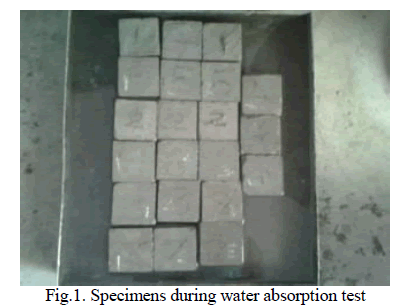 |
| Sorptivity (S) is a material property which characterizes the tendency of a porous material to absorb and transmit water by capillarity. Sorptivity can be determined by the measurement of the capillary rise absorption rate on reasonably homogeneous material. Water was used as the test fluid. The dried mortar specimens of size of 70.7mm x 70.7 mm x 70.7 mm were drowned in water with water level not more than 5 mm above the base of specimen .The flow from the peripheral surface is prevented by sealing it properly with non- absorbent coating as shown in Fig 2. The quantity of water absorbed in the time period of 30 minutes was measured by weighing the specimen on a top pan balance weighing machine. Surface water on the specimen was wiped off with a dampened tissue and each weighing operation was completed within 30 seconds. The cumulative water absorption (per unit area of the inflow surface) increases as the square root of elapsed time (t). The sorptivity of the specimens was found out using the following equation. |
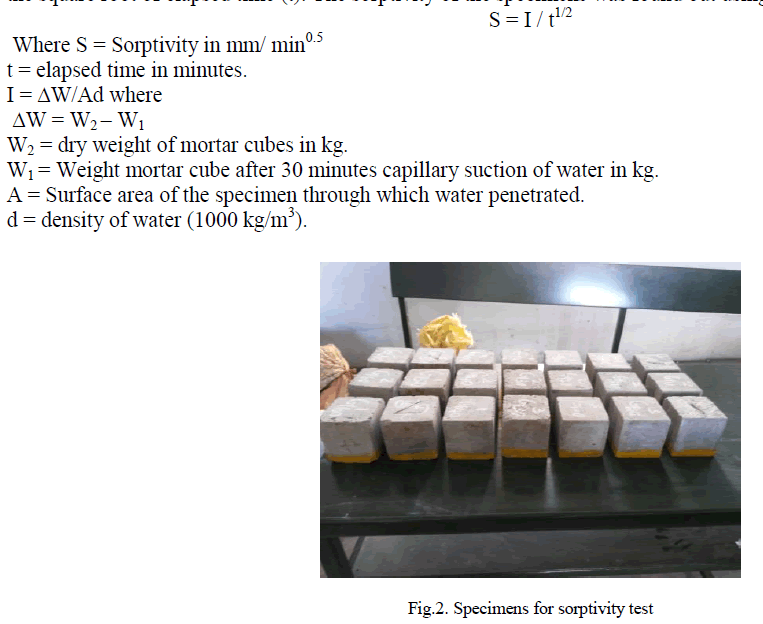 |
RESULTS AND DISCUSSION |
Density |
| The density values of mortar specimens for various mix proportions are given in Table 3. From Fig.3, it was observed that, for specimens without groundnut husk ash, the density values are comparatively higher as compared to that of specimens containing groundnut husk ash as fine aggregates. It was also seen that, density values decreases with increase in groundnut hush ash content. Density values are below 2100 kg/m3 when the groundnut husk ash content goes beyond 20%. |
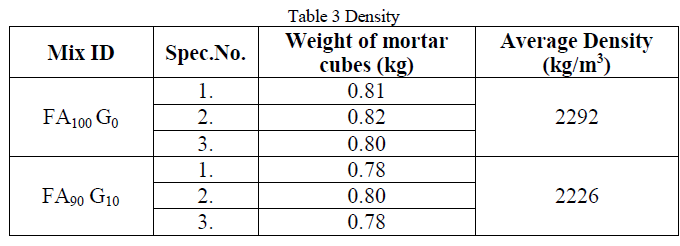 |
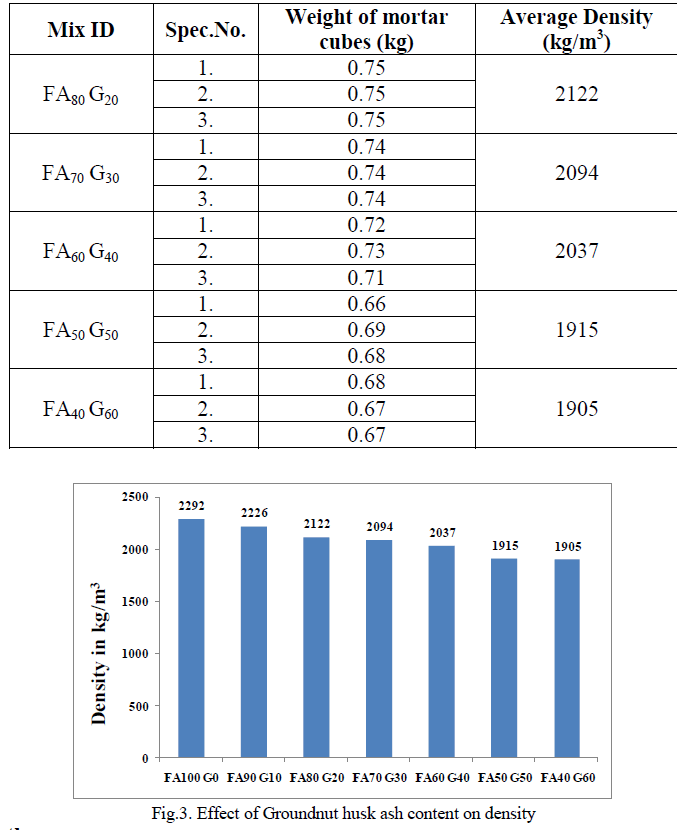 |
Compressive Strength |
| The compressive strength of mortar cubes for various mix proportions are given in Table 4. From Fig.4, it can be seen that, for specimens without groundnut husk ash, the compressive strength values are comparatively higher as compared to that of specimens containing groundnut husk ash as fine aggregates. It was also observed that, compressive strength decreases with increase in groundnut hush ash content. The reduction in compressive strength with respect to control specimens without groundnut husk is about 19%, 20%, 22%, 35%, 54% and 56% respectively. |
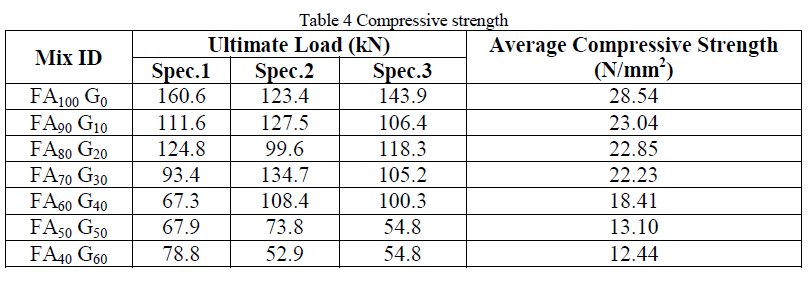 |
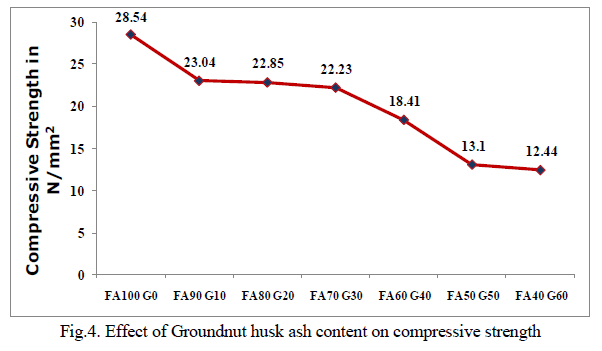 |
Water absorption |
| The values of saturated water absorption of the mortar specimens at 28 days were found out and tabulated in the Table 5. From the test results, it can be seen that the water absorption values for all the specimens for all the mix ratios were lower than 3%. It was also found that, for specimens without groundnut husk ash, the water absorption values are comparatively lower as compared to that of specimens containing groundnut husk ash as fine aggregates. It was also observed that, water absorption increases with increase in groundnut hush ash content. The water absorption increases by about 4%, 8%, 10%, 14%, 61% and 56% respectively with respect to control specimens without groundnut husk. |
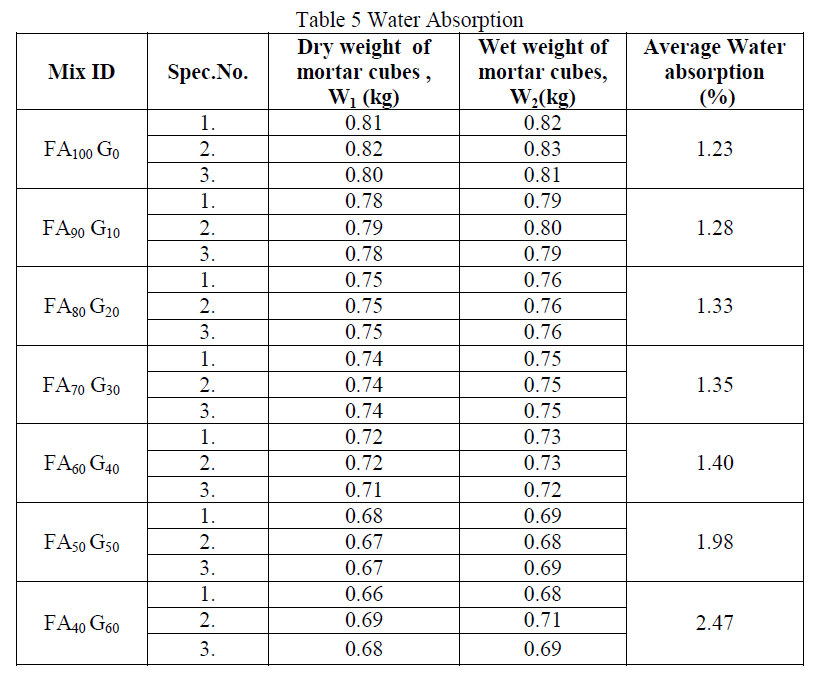 |
Sorptivity |
| The sorptivity values of mortar cubes for various mix proportions are given in Table 6.When groundnut husk ash is used as a replacement material for natural river sand, sorptivity coefficient increases as shown in Fig 5. This is due to the increased porosity in the paste. Sorptivity values of specimens containing 60% of groundnut husk ash as fine aggregates were too high which may be due to the presence of large number of capillary pores. Control specimens without groundnut husk ash have a denser structure as compared to specimens containing groundnut husk ash. |
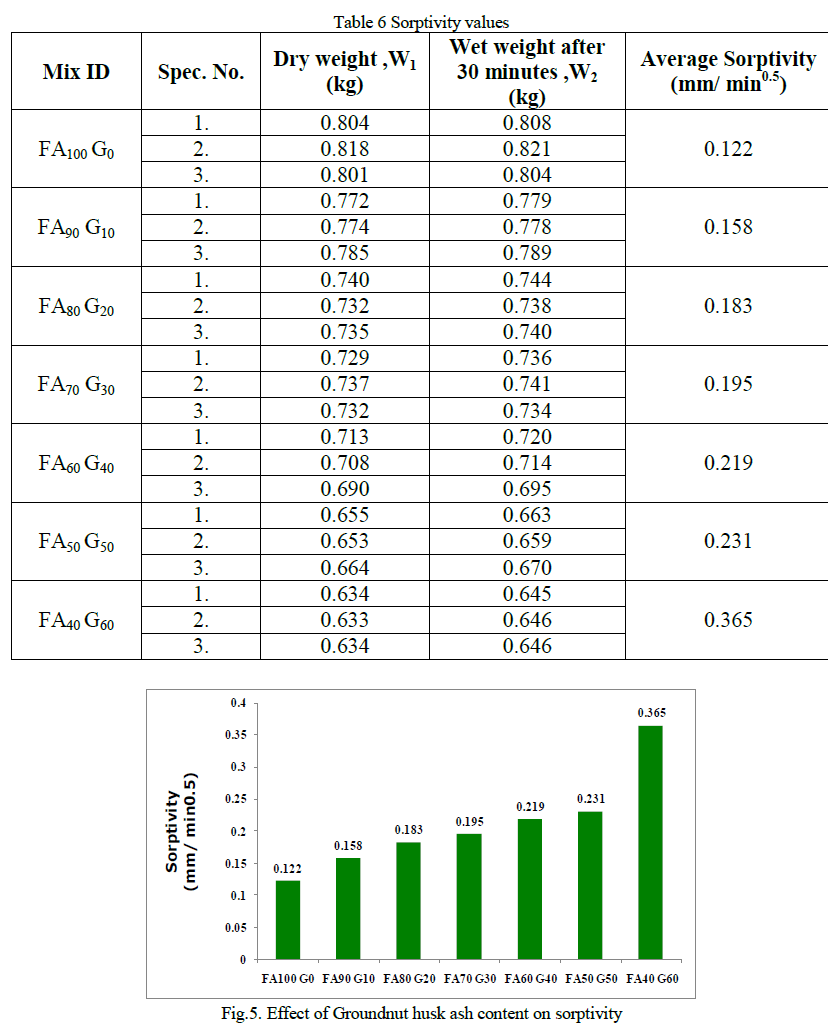 |
CONCLUSIONS |
| • The density of bricks is within the range of 1905-2292 kg/m3. Density values decreases with increase in Groundnut husk ash content. |
| • As the percentage of the Groundnut husk ash increases, the compressive strength of the mortar decreases. |
| • The water absorption and sorptivity values increases as the percentage of groundnut husk ash is increased. |
References |
|